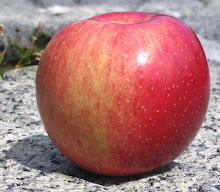Nineteenth-century handbooks classify and describe apples using charming, if enigmatic, terms such as aromatic and sprightly. The old descriptions have been cribbed and copied many times, with the result that many of these terms are still thrown about today; some old descriptions are on the Internet, word for word.
And why not? These varieties don't change: if they do, by cross-breeding or mutation, they become something else. One of the charms of heirloom and antique apples lies in their patrimony of taste. But though varieties don't change (if you can still find them at all), language does.
Today, at any rate sub-acid seems to be used interchangeably to mean "only a little acidity" or "no acidity," in effect just "not tart." It is more likely to be applied to antique varieties, reflecting I guess the practice of cutting and pasting apple descriptions from older works.
However, Honeycrisp, which is so modern its patent only expired last fall, is also described as sub-acid.
Originally, however, "sub-acid" seems to have been an intermediate category between sweet and tart. It is in wide use as such in J. J. Thomas's The American Fruit Culturist, first published in 1841.
It's tempting to use some of this old terminology, often evocative of meaning and of the 19th century, but "sub-acid" seems to have lost whatever precision it once had, except in a scientific sense, where it is sometimes defined as a measurable PH range of low acidity, just north of neutral. Perhaps a grower can set me straight on this.
Historical note: Thomas was not the first to call some apples "sub-acid," but the term does not appear at all in William Coxe's earlier (1817) work. Note its absurdly long title.

Comments
Post a Comment
Join the conversation! We'd love to know what you think.